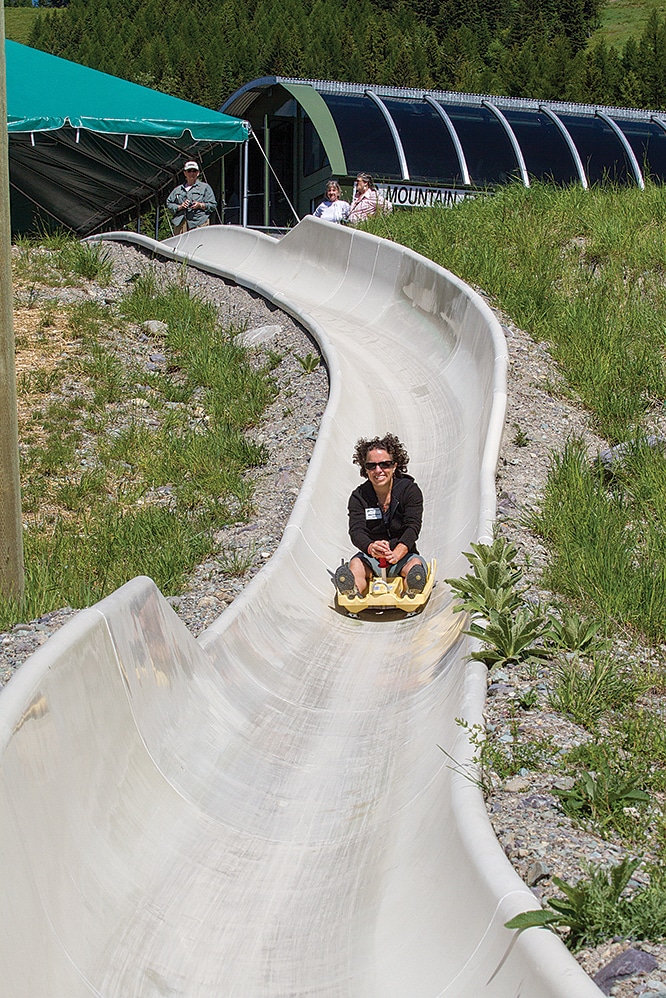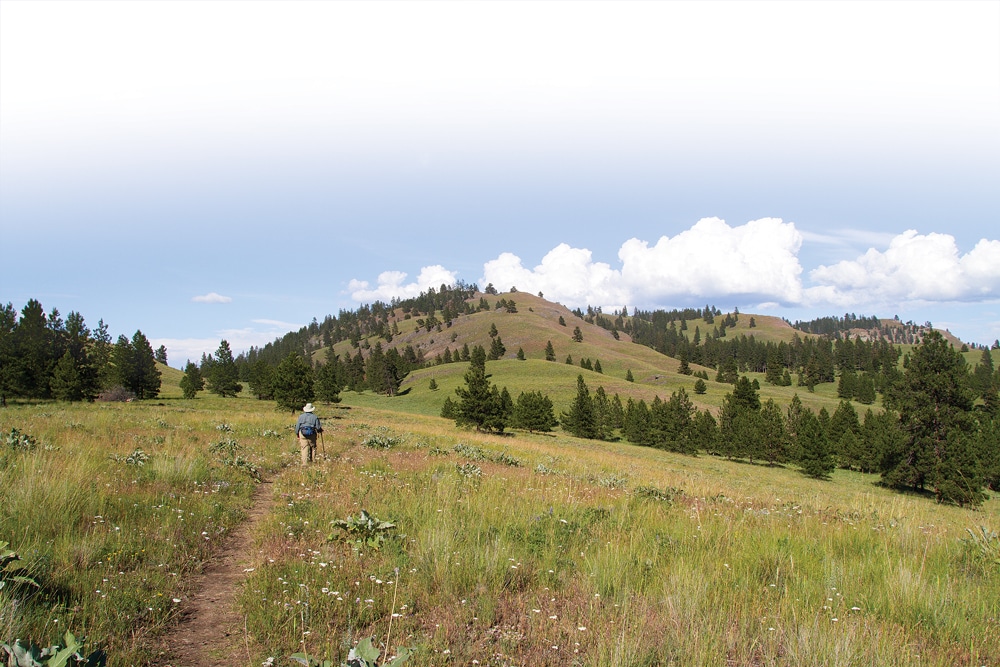Whitewater rafting, hiking, road touring and RVing in northwestern Big Sky Country
Spectacular landscape, soaring mountains, crystal-clear lakes and blue-ribbon trout streams – there are plenty of postcard views in the RV-friendly Glacier Country of  northwestern Montana. We’re headed there for a taste of this amazing part of the West.
northwestern Montana. We’re headed there for a taste of this amazing part of the West.
We begin our journey in the southern tier of Glacier Country in Missoula, the state’s hip cultural hub. This college town of 70,000 is a vibrant community with a walkable downtown with plenty of turn-of-the-century stone buildings, the state’s oldest brewery, and good restaurants and shops to explore.
Since we want to begin with an authentic flavor of Montana, we head to the edge of town to the Missoula Smokejumper Visitors Center. Smokejumpers are elite firefighters who parachute into backcountry wildfires, and Missoula has the largest smokejumper training base in the country. Just inside the visitors center is a replica of an early fire lookout complete with bed, binoculars, maps, food and other essentials fire scouts needed to do their lonely job.
We join a free, 45-minute tour that includes fascinating displays, dioramas and videos about this grueling career. There’s an exhibit of the gear a smokejumper takes with him/her – all 120 pounds of it. Another showcases what jumpers eat, as much as 6,000 calories a day, including plenty of high-calorie Spam.
In the parachute loft, huge billowy cloths hang from the ceiling. A parachute – the jumper’s lifeline – weighs 23 pounds and must be packed out. Smokejumpers are also responsible for making their own gear and we’re surprised to see brawny, grizzled men hunched intently over sewing machines. By the time our tour is finished, we’re thoroughly impressed with these dedicated firefighters.
We want to explore Missoula’s downtown, but the smell of propane prompts us to stop at Rangitsch Brothers RV near the Smokejumper Center. It’s late on a Friday afternoon and the service manager thinks our LP-gas leak is a quick fix. It’s not. Despite previous Friday night plans, two mechanics cheerfully spend four hours tightening, replacing and repairing everything that could possibly seep propane. We leave with a surprisingly reasonable repair bill and our rig is good as new.
Jim and Mary’s RV Park on U.S. Highway 93N is our home for the night. This shady, tree-lined park is popular and we’re glad we made reservations for one of its 70 full-hookup sites with picnic tables, 24-hour laundry, free showers and spacious community room. While there’s a faint din from the freeway and the whistle from an occasional train, we wearily sleep like babies.
Seeley-Swan Valley, Whitewater

Driving the Going-to-the-Sun Road in Glacier National Park affords views of McDonald Creek, which runs for more than 25 miles in the park.
The next morning, under gorgeous blue skies, we head east on Interstate 90 to State Highway 200 so we can drive scenic State Highway 83N through beautiful Seeley-Swan Valley. We pass through Milltown and Bonner, the latter with its identical company houses lined shoulder to shoulder, crossing the wide Blackfoot River and climbing into evergreen-lined canyons and then through wide valleys dotted with ranches. With hawks circling lazily overhead and puffy thunderheads gathering against distant mountains, it’s easy to see why they call Montana Big Sky Country.
Shortly we come to Salmon Lake, a gorgeous blue-black lake nestled along the Clearwater River between the Mission and Swan mountain ranges and Salmon Lake State Park. It’s tempting to set-up camp in the RV on this fish-rich lake with 20 sites, but it’s early in the day so we keep driving.
We pull into Seeley Lake, a modest gathering of cafés and bait-and-tackle stores surrounded by the snowcapped Swan Mountains, including Monture Mountain, which looms 8,289 feet over the northeast end of town. We drive along the heavily forested road with peek-a-boo views of Seeley Lake, then a series of pretty lakes in the Clearwater chain, including Alva and Summit lake, where we pause to snap photos of the water with the Mission Mountains as the backdrop.
 We climb higher and higher into Swan River State Forest. At 4,300 feet, white-barked aspens stand in sharp relief to deep-green firs and pines. We drive through Swan Lake, a tiny burg with a trading post, volunteer fire department and canoe shop, and then through Creston (via State Highway 35N) with its fields of spring wheat.
We climb higher and higher into Swan River State Forest. At 4,300 feet, white-barked aspens stand in sharp relief to deep-green firs and pines. We drive through Swan Lake, a tiny burg with a trading post, volunteer fire department and canoe shop, and then through Creston (via State Highway 35N) with its fields of spring wheat.
We turn north onto U.S. Highway 2 and cruise along the silty Flathead River. In Hungry Horse, we stop at the Huckleberry Patch pie shop and pick up slices. Then it’s back north on the highway to Montana Raft Company, a rafting and guide service where we made reservations.
We gear up in neoprene wet suits and life vests and board an old-school bus for the short ride to a creek joining the Middle Fork of the Flathead River. We’re assigned to one of three rafts and our crew paddles into the brown, rushing water. The river is running fast from rain and snow melt, so many of the Class II and III rapids on this half-day trip through John Stevens Canyon along the southwestern boundary of Glacier National Park have been swallowed by high water. The trip is still thrilling with whitecap drops and rapids. At one point, our raft plunges and we spin around. I nearly end up in the silty water, but my death grip on the center rope saves me.
We’re ravenous from the paddling so we head to Belton Chalet in West Glacier, an upscale restaurant located in a historic railroad hotel. Built in 1910 and fully restored, the old hotel and eatery, a National Trust for Historic Preservation landmark, features original wood porches, stairways, floors and turn-of-the century furnishings.
We pull into San-Suz-Ed, a family-owned forested RV campground, for the night. We’re too tired to join the festivities around the campfire, but we appreciate the quiet, level site.
Glacier National Park, Whitefish Adventures
The next morning, we head to Glacier National Park. It’s been an unusually heavy snow year and we’d planned to tour iconic Going-to-the-Sun Road on a Red Bus tour, but the road to Logan Pass is closed. (Going-to-the-Sun Road from Avalanche Campground to the Rising Sun picnic area parking is closed to RVs more than 21 feet long.) Instead, we cruise along the part of the road that’s open and pull over frequently to shoot pictures of Lake McDonald and the towering mountains mirrored in it – Howe Ridge, Stanton Peak, Mount Vaught, the Garden Wall, Mount Cannon, Mount Brown, Little Matterhorn, Edwards Mountain, Gunsight Mountain and Snyder Ridge. We pull in at McDonald Creek to watch its torrent of water, glacial green with rock “flour,” roar through the canyon. Above the water, sheer walls of granite rise up, their stony faces striated with cascading waterfalls.

At the Whitefish Mountain Resort’s Aerial Adventure Park, guests clip onto safety lines and work their way through the trees.
Later that afternoon, we jump on a vintage Red Bus for the 3.5-hour Huckleberry Mountain Tour. Our friendly driver, Tenaya, a science teacher from Minnesota, expertly navigates the 25-foot-long 1936 White Motor Co. bus through cedar- and hemlock-lined roads. She tells us that this is the easternmost stretch of Pacific Northwest rainforest. In addition to cedar and hemlock, these thick forests contain western larch, western red cedar, white birch and black cottonwood on the west side, and quaking aspen and lodgepole pine on the east.
The park covers more than a million acres, 131 named lakes, parts of two mountain ranges, 1,000-plus species of plants, and 250 grizzly and 500 black bears. It’s a wild place subject to fire, floods, heavy snow and avalanches. The park is dynamic and even its namesake glaciers are in flux – 150 glaciers in 1910, 25 today. Experts estimate by 2030, all may be gone.
West Glacier KOA is our berth for the night. It’s a tidy, spacious park with an ice cream store, a well-stocked camp store and boutique, and an outdoor barbecue restaurant serving ribs and steaks. The campground offers full hookups with pull-through and back-in, gravel-topped sites. I forgo the pool, but spend an hour working out road kinks in the spa. After some smoky ribs and corn on the cob, we retreat for a quiet night beneath the trees.
Early the next morning we’re back on U.S. Highway 2 and heading west to Whitefish, a cute-as-a-button resort town that’s home to Whitefish Mountain Resort, where we hop the chairlift to the summit. At 6,817 feet, the 360-degree views are spectacular (all the way into Canada!) and we hungrily shoot pictures. With 105 marked runs and 3,000 acres of skier- and rider-accessible terrain, it’s easy to see why Whitefish is a wintertime favorite. They’ve got plenty of summertime adrenaline-pumping adventures too. There’s a zip line, an alpine slide, nearly 30 miles of mountain-bike trails, a high-rise nature walk through the forest canopy, and a challenging aerial adventure park with tree-to-tree suspended bridges, walkways, nets and ladders. We don’t have time to experience these activities, so instead we take a short forest hike and make a note to come back. (While the resort doesn’t have an RV park or hookups, in summer, RVers are allowed to park overnight in the parking lot for free.)
We jump on U.S. Highway 93S, a four-lane divided highway, and cruise into Kalispell, a true-to-its-roots Western town in Flathead Valley. We stop at the Museum at Central School, a three-story brick school built in 1894 that’s been renovated into a cool museum featuring artifacts and exhibits on area logging, wildlife and native peoples (which includes a rare grizzly bear necklace).
We’re driving alongside Flathead Lake, at 27 miles long and 15 miles wide, the largest freshwater lake west of the Mississippi. We meet up on a lakeside dock with a couple of families and the owner of Flathead Raft Co. for a tour of the lake and Wild Horse Island State Park. The 2,100-acre park got its name from Salish-Kootenai Indians who pastured horses here to keep them from being stolen. Today, the island is home to five wild horses as well as bighorn sheep, mule deer, songbirds, waterfowl, and plenty of falcons and bald eagles.
As we motor toward the island, our guide tells us that Flathead Lake is a remnant of the great Missoula Flood that occurred between ice ages, and it’s a favorite with fishermen for perch, whitefish, lake and rainbow trout, and kokanee salmon (small landlocked salmon). Near the island, a couple dozen comical bighorn sheep dash onto a dock to greet us. While there’s no overnight camping allowed, hiking is popular and we spend an hour traversing well-marked trails, passing by old homesteads that speak to the island’s past.
The sun is setting and a cooling breeze rises off the water as we pull away from Wild Horse Island. We watch a pair of bald eagles dive repeatedly into the azure blue water and know that grand Glacier Country is worth visiting again and again.
Local RV Parks
Columbia Falls RV Park
888-401-7268 | www.columbiafallsrvpark.com
Glacier Haven RV and Campground
406-888-9987 | http://glacierhavenrvcampground.com
Glacier Pines
800-533-4029 | www.glacierpines.com
Jellystone RV Park
800-318-9644 | www.jellystonemt.com
Jim and Mary’s RV Park
406-549-4416 | www.jimandmarys.com
North American RV Park & Yurt Village
800-704-4266 | www.northamericanrvpark.com
San-Suz-Ed RV Park
800-630-2623 | www.sansuzedrvpark.com
West Glacier KOA
406-387-5341 | www.westglacierkoa.com







